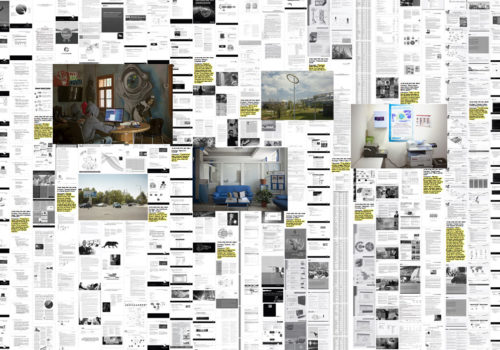The Open Society Documentary Photography Project aims to be a place to reflect on how photography can help us understand the world today and provides for the first time a police theme for his exhibition Moving Walls. Spying is no longer reserved for the charming spy named James Bond. With new tools like drones, satellites and other security systems, the mass of images of and data on the citizens of the world has become increasingly important and accessible both to governments and the general public. Be it paradoxical, surveillance has become omnipresent to the point of being accessible.
“The problem isn’t the number of photographs, but how they’re acquired,” warns Mishka Henner. With a touch of humor, he looks at the unique way in which the Dutch government tried to conceal a number of sites it considered important: military barracks, oil depots, and other royal palaces. Henner navigated on Google Earth above these sites, that have been transformed into multicolored polygons by a poor retouching job, and he framed from the overview several landscapes of absurd and abstract shapes. The result transforms the way we consider the representation of the landscape in the visual arts.
The Dutch government openly shows that it hides, others make their technology accessible to all. Andrew Hammerand did not have to wait for the opinion of Her Majesty to seize a surveillance camera installed in an idealized planned community in the American Midwest and to explore its aesthetic possibilities. He traded a Leica for a CCTV camera. “The low resolution is the new film grain”, he claims. This is the New City (The New Town), says the title – a utopian city, fully observed, and this city has left the world of science fiction.
Does it mean that everything is accessible, and at what price? Mari Bastashevski opened a file on monitoring companies such as FinFisher, and has since been studying the paradox between their promise and the very nature of their business. In order to assess the vulnerability inherent to safety, she is investigating a tensed territory that regularly investigates her back. “It’s nothing personal,” she states with her title, as an excuse. What she explores is the boundary between the visible and the invisible, between what is possible to see and to hide and how this unsolvable question generates an anxiety that affects all individuals.
In other terms, what do we see in the flood of images that are available? Hasan Elahi asked the question directly to the FBI, who erroneously linked him to terrorist activities. “I decided to give the FBI a helping hand”, he says. The help consisted in sending them 700 000 images of his daily routine actions, from the airports he transited through to the bathroom. Nobody knows what the Bureau saw in these images, neither what else they saw – it’s left to everyone to see and decide.
What a young teenager saw in Pakistan was her grandmother killed by a drone as she picked okra in her garden. Since then, he doesn’t like cloudless days: the sun may be out, but it’s also the ideal conditions for flying drones. Using drones himself, Tomas Van Houtryve makes aerial photographs in which he develops a novel aesthetic language made out of geometric shapes and projected shadows, evoking photographs by the masters of formalism like Harry Callahan and Laszlo Moholy-Nagy as well as the aerial photographs taken for archaeological, geological or military observation missions since the 50s.
These are the decades in which dug Simon Menner, who browsed the archives of the Stasi and chose to show the burlesque parties of its agents, the language of their hands and their ostentatious costumes. These records are open to the public and yet, like many of the images of the past and of today, will never be seen since they are not meant to. The idea of surveillance ensures the control mainly, not the information it provides. This is the basis of dictatorships.
On assignment for the Wall Street Journal, Edu Bayer was given access for half an hour to Gaddafi’s former surveillance center, shortly after the fall of the Libyan regime. Left alone in these messy offices, he felt the gap between the reality of the surveillance system and the fear it spread. He shot what he saw, and just as every photographer in the exhibition, he confronted the monitoring process to their results. Josh Begley managed to break down the NSA’s archival and collection system – a system that, he notes, has never provided the agency with any lead despite its stunning accuracy. Julian Roeder shot staged photographs of Eurosur, the system monitoring European borders. Paolo Cirio printed in the street and in full size posters of passersby captured by Google Street View.
With radical and varied visual responses, the ten photographers in this edition of Moving Walls take a long view of the question of surveillance. The thematic curation orchestrated by Yukiko Yamagata, Susan Meiselas and Stuart Alexander reflects on the scope of documentary photography and the universal means available to decipher the most critical issues of our times – times when, as Mari Bastashevski remarked, there is no real difference in the ways power is managed in the East and West.
















